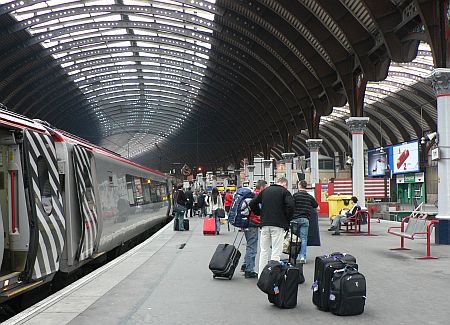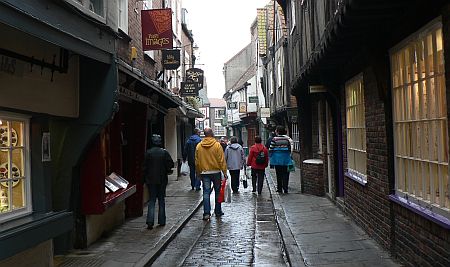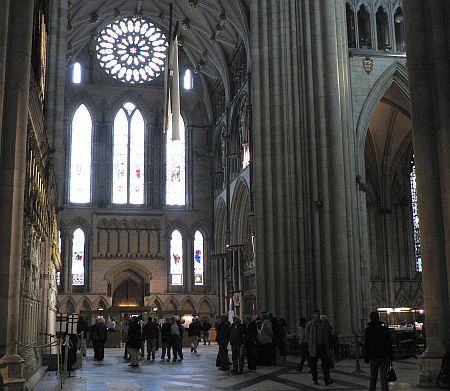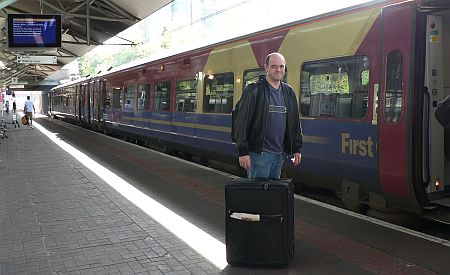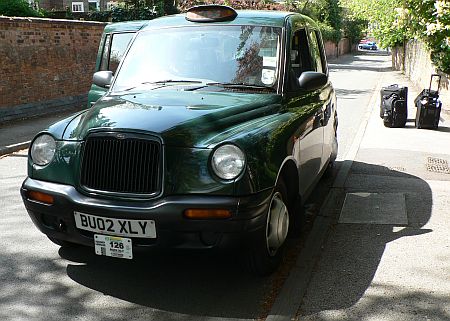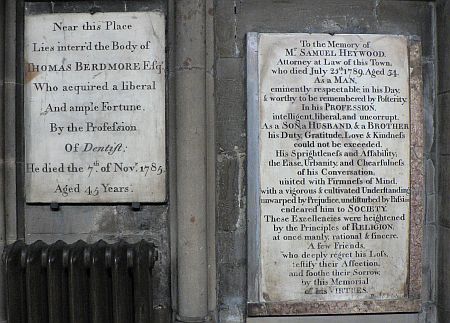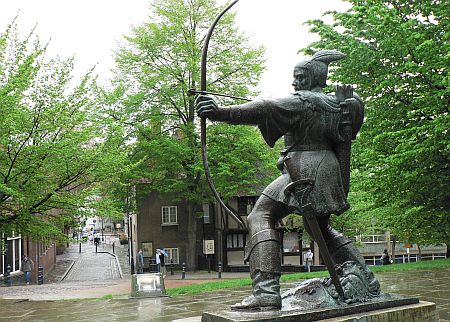Yesterday, my surgery was scheduled for 1:35 p.m. Diana and I went the requisite 2 hours early, and checked into the day surgery clinic (on the fifth floor at St. Michael’s Hospital). It’s been designed as a welcoming place — some benefactors must have spent some time there! — with a wood panel reception area. We were directed down a very long hall — the place is huge — and were given a cubicle large enough for a reclining chair and two guest chairs. The curtain was drawn in front, and I was given the usual hospital gown (actually designed with a side slit) and a very large white terry bathrobe. I removed my street clothes, and was down to underwear and socks under the bathrobe. The nurses went about to correct the attendant who had brought me down: for cataract surgery, they’re only interested in the head, so I could actually have kept my pants on. I opted to stay in my underwear, because it’s about as comfortable as being in my shorts at home.
A nurse came in to do the usual medical history, and put a catheter in the back of my right hand for the anaesthetic. Diana and I chatted for for about 45 minutes until the intern came. At that point, I handed over my glasses to Diana, so I wasn’t seeing much, either out of the left eye with the cataract, or my normal myopic right eye! I was wearing little booties over my socks, and the staff decided that I might as well walk down to the operating room (rather than take a wheelchair).
As the operating staff introduced themselves — it was impossible for me to make them out without my glasses! — I got up onto the operating table. They put a folded towel under my head, and then — rip, in a sound like a roll of Scotch tape! — they wrapped a strip of tape over my forehead and under the operating table. I remarked that this seemed primitive, but obviously functional. The staff bundled me up in warm towels, including a little tunnel for my left arm. I remember the nurse introducing herself, as she must have connected the catheter in my right hand to the anaesthetic. I remember the intern telling me that he was going to clean my left eye with three swabs of cleanser, counting 1 … seeing yellow … counting 2 …. and then … I don’t remember much.
In the pre-admission visit, the doctor had said that cataract surgery calls for a light anaethetic, because the patient has to be awake to respond to requests to move the eye. I can imagine that I was awake, but I really don’t remember anything. I do remember a few voices as they were working through the surgery … it sounded like they were having a little difficulty getting out my cataract, and I heard when they said that the artificial lens was put in … but everything else is pretty much a blur. I barely remember them taking off all of the blankets, getting down off the operating table, and then getting wheeled down to the recovery area. The surgery probably took about an hour.
The nurses asked me for Diana’s name, and she got paged to join me. (She doesn’t get called as Diana Ing very often). The nurses took my blood pressure, and gave me a turkey sandwich and apple juice. (It was annoying to be fasting since midnight the night before, but I was the last surgery of the day). I wasn’t feeling any real pain, just a slight sensation of a dry eye. I put on my street clothes, got in a wheelchair pushed down to the front door, and Diana and I took a cab home.
At home, I had some soup (I was on a cooking spurt on Saturday, having found tarkeys on sale for half price on Friday!). I watched tv in bed, and put in eye drops every hour. I guess that I fell asleep about 6:30 p.m., for a few hours. When I woke up, I decided to pop out the left lens from my glasses, which seemed to show that I had normal vision in the left eye, but I really couldn’t get my right and left eyes to line up. I had some cereal, watched some more tv, and went to sleep.
This morning, I had a shower, and decided to put in my right contact lens so that I could wear sunglasses to my post-op appointment. (It’s actually a rainy day). I actually haven’t worn contact lenses since last June, because my optometrist then said that glasses would allow more light into my left eye. Now, however, a contact lens works best. There’s no disparity, as with a pair of glasses with only the right lens in. One thing that I do notice is a slight colour difference between my eyes: the right eye has a slight yellow tinge in it, as I guess my natural lens is getting old.
Diana drove me over to the eye clinic. As we were passing over the Richmond Street viaduct, it’s interesting to observe how blind I was in driving with the cataract in one eye. Sure, I could see, but it was pretty much tunnel vision. With two eyes this morning, I could see traffic, the building, the trees. It was an amazing, joyous feeling.
At the eye clinic, the intern saw me first. He looked into the eye, and said that the lens was perfectly centered. I read the eye chart, and he said that I have 20/20 vision. I asked about the lens that they put in yesterday. He said that my eye is about 6, and they put in a lens to correct to 8. Of course, the downside is that I’m now farsighted in the left eye, so I really need reading glasses. The intern said that the human brain will adapt, so I’ll probably start reading more out of my right eye. He also said that my left eye is still dilated, so my vision should improve over the next few days. He was a bit concerned about a bit of pressure in my eye, but Dr. Squires, joining us, mentioned that the pressure was there before the surgery. I asked what I can and can’t do until the final checkup in three weeks, and Dr. Squires said no jumping up and down — so there goes badminton — no heavy lifting or exertion — so there goes bicycling — but otherwise I can live pretty normally (including showering!)
I’ll get fitted for glasses at the appointment in three weeks. In the meantime, my long vision is great, but with drops in my eye from this morning’s exam, it’s hard for me to judge what life will be like over the next three weeks. In a reversal of the condition before the operation, I can see long distances well enough to drive, but have found newspaper type to be illegible. I’ve been playing with the font sizes on Windows XP, so I can be functional on the computer — albeit with less screen real estate!
[Blogging note: I’ behind maybe 6 posts on multiple blogs, so I’ll be playing catch up over the next few days. WordPress has a feature that enables changing posting dates, so the entries on Fuschl, Finland, Manchester and Hull will still appear in correct date order.]

